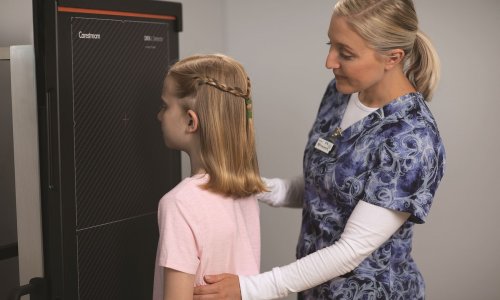Tracking equipment performance is vital to control radiation dose
By Jacqueline Gallet
Although there should always be concern about radiation in a facility that uses X-ray to image patients, that concern is perhaps not as vocal as for CT or interventional radiology, according to physicist Jacqueline Gallet, Global Manager of Clinical Studies at Carestream Health.

‘X-ray equipment is still very minimal in terms of patient radiation and digital equipment has improved on that by going from film screen into digital. We have better management in terms of image processing. We also have quality control tools that can help in controlling the dose in X-ray facilities. You need radiation to produce an image, the type of the detector and the means by which you acquire that data varies. Therefore, some equipment may need a bit more. It is also very subjective in terms of the radiologist looking at an image. One radiologist may say, I’m okay, but another may say I need to see more, in which case you sometimes have to irradiate the patient a bit more. Also, you may be looking at a hard copy or soft copy – if looking at soft copy images, the quality control that you’d have on your monitors is very important. Monitors can deteriorate very rapidly. The radiologist may not necessarily notice this and keep insisting that there’s something wrong, or that you need more dose, but in fact it is really the equipment that has not been tracked properly, and it may not be performing the way it should be performing.’
How can tracking be controlled?
‘A facility should have a medical physicist. If it doesn’t, there should be a quality control technologist or imaging manager who tracks that kind of information. Carestream provides quality control tools and instruction on how to track the performance of the equipment, and we can help with any ongoing programme as it evolves in a facility. This is very important in also monitoring the correct dose to a patient. If you don’t have a quality control programme within the facility, it is very easy for a radiographer to increase doses – perhaps very imperceptibly at first – in order to correct for system minor malfunctions or even for a monitor degrading.
So it depends not so much on the system, but on the skill of a radiographer or radiologist?
Yes, the radiologist determines the quality of the image that he wants to read, whether or not it has a high radiation dose. The radiologist must make the final diagnosis. So the radiographer will abide by what the radiologist wants in the facility. But again, it is very subjective. One radiologist will be very happy reading a slightly noisier image compared with someone else. This can be a problem.
In equipment comparisons among radiologists someone said that Carestream equipment needs high dosage, which is not true.
‘Correct. Competitors have used that exact phrase. It is not true. It depends on how a facility is tracking, and whether it is really concerned about the patient dose. The radiologist is the end viewer. So we train the radiographer. The radiologist approves or does not approve or provides comments as to the quality of the image that he or she wants to see. If you have a good radiographer who understands image processing, now we are talking about digital, and we have that aspect of the image processing that can be adjusted to provide the quality that the radiologist would like to see. The more robust your image processing is, the more you can provide a better image at a lower dose to the patient. More than just dose comes in to image quality.
Is there a difference in how, for example, European, American, Asian, African or Russian radiologists deal with the question of radiation dose?
I’ve been questioned about dose in other regions, but perhaps not to the extent received from Europe. You have particular groups, such as paediatricians, who are generally more concerned about the patient dose.
In Europe, this is also a political situation; there are groups that want to avoid a lot of CTs, for whatever reasons. Is that the case in the USA?
For CT? Certainly there is a push to lower the dose in paediatrics – a national push. MR is a different part of the spectrum. I’ve not seen anything as disconcerting as a dose in CT. I’ve not seen that much coming out of MR, which is a different type of electro-magnetic radiation. It can do other things that are harmful.
Are you trying to develop material to lead to less radiation in CT?
We are always on a path toward lowering the amount of radiation that we need in order to produce an image. That is part of all of these product lines that we develop. In terms of image processing, we are always developing image processing so that you can extract the most out of the acquired signal. This is one of the two biggest areas; the other is the actual detector technology. Certainly informing and teaching the user how to best use the equipment is also a big factor, and introducing quality control tools to monitor and track equipment properly. As a company, we are concerned about the patient dose. We want to provide the best image quality and the lowest possible dose to our users, and we are continuously improving our products along that mind frame.’
28.10.2008











